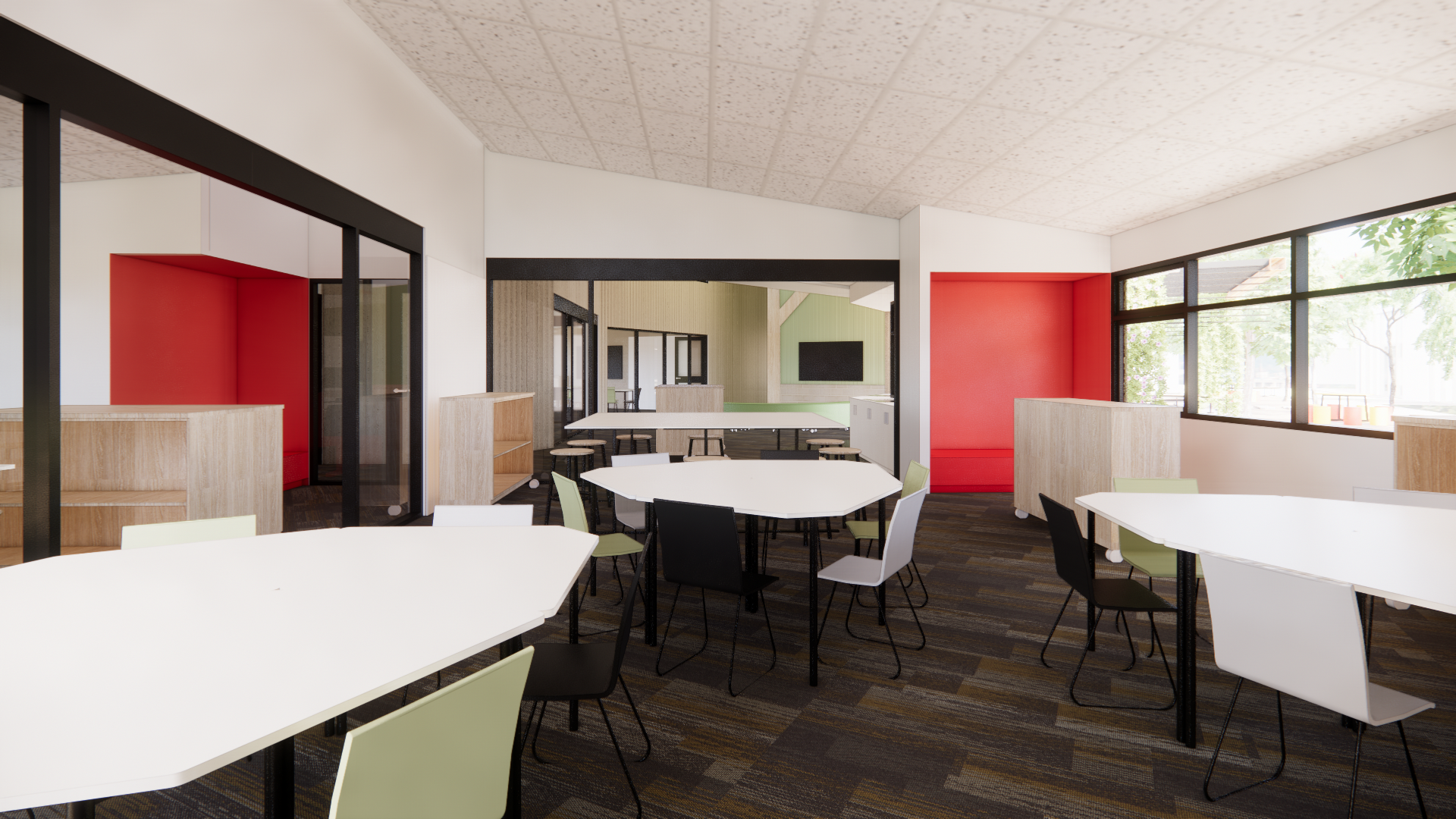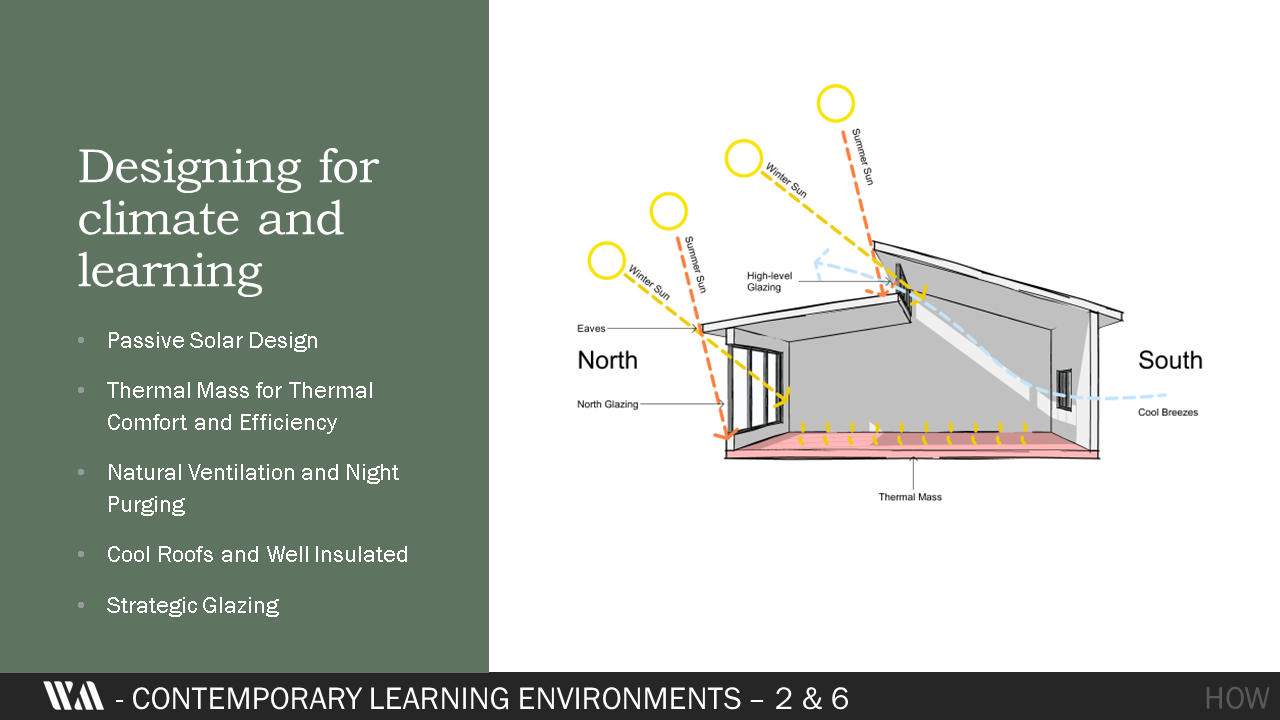Designing for Learning: School Building Planning
The ‘Designing for Learning’ series of articles has been designed as a resource and guide for educators undertaking or wishing to undertake capital works projects on their campus. Our aim is to provide a base understanding of the intersection between pedagogy and architecture - bridging the gap between architects, educators, and community stakeholders. These are not scholarly articles but we do endeavour to reference relevant experts in this field. It is written by Audrey Whisker, an architect based in Melbourne, Victoria, Australia with extensive experience working with the Department of Education, Victorian School Building Authority (VSBA) and as registered architects on the Construction Supplier Register (CSR).
This article is most useful in the Schematic Design Stage.
School building design is a key factor in creating a functional and effective learning environment for students. A well-designed school building can improve student performance, reduce distractions, and create a sense of community and belonging. On the other hand, a poorly designed school can hinder learning and create a negative atmosphere for students.
One key aspect of school building design is ensuring that the layout is functional and efficient. This includes placing classrooms, offices, and other facilities in logical locations, as well as creating clear and easy-to-follow paths for students and staff. The layout should also consider the needs of students with disabilities, ensuring that they have access to all areas of the building.
Another crucial factor in school building design is the use of natural light and ventilation. Natural light has been shown to improve student performance and well-being, so incorporating large windows and skylights into the design can be beneficial. Ventilation is also important, as it helps to regulate the temperature and air quality within the building.
Technology is another important consideration in modern school building design. Many schools are now incorporating technology into the classroom, so it’s important to ensure that the building has the necessary infrastructure to support this. This includes things like high-speed internet and electrical outlets in every classroom.
Safety is another key aspect of school building design. This includes both physical safety measures, such as fire exits and sprinkler systems, as well as security measures to prevent unauthorised access to the building.
Incorporating sustainability into school building design is also becoming increasingly important. This can include things like using energy-efficient materials and appliances and incorporating green spaces into the design. Not only does this help to reduce the school’s carbon footprint, but it can also provide a positive learning environment for students.
Overall, designing a school building requires careful consideration of a wide range of factors, from layout and natural light to technology and sustainability. By taking all these things into account, schools can create an effective and welcoming learning environment for their students.
History of School Building Design
Throughout history, the design of school buildings has evolved significantly. From ancient Greek academies to 21st century learning neighbourhoods, the way in which students learn and interact with their environment has shaped the design of these buildings. Here is a brief overview of some of the most influential historical school building designs.
Ancient Greek Academies: The earliest known school building was the Academy in ancient Greece, founded by Plato in 387 BC. These academies were designed as open-air spaces, with rows of benches and a central platform where teachers could stand to lecture. The focus was on oral tradition and discussion, rather than written materials.
Medieval Monasteries: During the Middle Ages, education was largely confined to religious institutions, such as monasteries. These buildings were designed to accommodate both living quarters for the monks and classrooms for teaching. They were typically constructed with large, open spaces for the monks to sleep in, as well as smaller classrooms for teaching and study.
Renaissance Universities: As education became more widely available in the Renaissance, universities began to emerge. These buildings were designed to be grand and impressive, with large lecture halls, libraries, and classrooms. Many of these universities, such as the University of Bologna in Italy, are still in operation today and have maintained their original architectural style.
Victorian Public Schools: In the 19th century, the Industrial Revolution led to a growth in public education and the construction of many new school buildings. These buildings were typically designed in the Victorian style, with red brick exteriors and large windows to let in natural light. The classrooms were spacious and well-ventilated, with high ceilings and large windows to allow for plenty of natural light. The teaching was still very teacher-focussed and relied heavily on didactic instruction and rote learning.
Modern High Schools: In the 20th century, school building design became more functional and practical. High schools were designed with a focus on efficiency, with classrooms arranged in a linear fashion and connected by corridors. These buildings often had multiple floors and were designed to accommodate a large number of students.
Overall, the design of school buildings has evolved significantly over the centuries. From ancient Greek academies to modern-day high schools, the way in which students learn and interact with their environment has shaped the design of these buildings. Each period has contributed its own unique style and innovations to the design of educational spaces.
“The principal quietly states his concern that this classroom says more about the needs of the teacher rather than a classroom where students are encouraged to experiment, take risks, and explore. The teachers’ desks play a prominent role in each room, taking up to 25% of the classroom floor space. Whiteboards at the ‘front’ of the classroom suggest a particular teacher-focused mode of learning.”
Defining the Pedagogical Vision
A pedagogical vision is the guiding philosophy that shapes the way a teacher approaches education and instruction. It is a clear and coherent set of beliefs about teaching and learning that inform the teacher's decisions and actions in the classroom. A strong pedagogical vision can help teachers create a positive and engaging learning environment, and it can also serve as a roadmap for continuous professional development and growth.
So, how do you go about defining the pedagogical vision of a school? Most schools define the direction their teaching will take through an understanding of the values of their community, the values instilled in the history of the school, and the personal vision and values of those on the leadership committee. Here are some steps for each member of the committee to consider:
Reflect on your own beliefs and values about teaching and learning. What are your goals as a teacher? What do you believe is important for your students to learn and how do you want them to learn it?
Your personal teaching style and strengths. How do you naturally approach teaching and learning, and how can you build on those strengths to create a successful learning environment for your students?
Research and explore different teaching approaches and theories. There are many different approaches to teaching and learning, and it can be helpful to learn about and consider different perspectives.
Identify your target audience. Who are your students and what are their needs, interests, and abilities? How can your pedagogical vision support and meet the needs of your students?
Consider your teaching context. What resources and support are available to you and your students? How can you make the most of these resources to achieve your teaching goals?
Once you have a clear idea of your pedagogical vision, it's important to communicate it to your students and colleagues. This can help create a shared understanding of your teaching goals and expectations, and it can also help to build a positive and collaborative learning community.
Overall, defining a pedagogical vision is an ongoing process that requires reflection, research, and consideration of your own beliefs and values, teaching style, and target audience. By taking the time to thoughtfully define and communicate your pedagogical vision, you can create a positive and engaging learning environment for your students and foster their growth and development.
“A useful question for teachers to consider is who owns the learning spaces? Who controls movement and behaviour? Are students able to physically adjust their environment to personalise with their work[...]? Does control stay with the teacher all day or does it shift between students and the teacher?”
The Importance of User Engagement in School Design
When designing a school, user engagement is a crucial factor to consider. User engagement refers to the level of involvement and interaction that students, teachers, and other stakeholders have with their learning environment. It can impact everything from the way students learn and retain information to the overall culture and atmosphere of the school.
One of the main benefits of high user engagement is that it can lead to improved academic outcomes. Students who are actively engaged in their learning process tend to have higher levels of motivation, which can lead to better grades and a greater understanding of the material. Teachers can encourage user engagement by designing lessons that involve hands-on activities and group work, which helps students feel more invested in their education.
Additionally, user engagement can foster a sense of community within a school. When students feel like they have a say in their learning environment, they are more likely to feel connected to their school and their peers. This can lead to a positive school culture, where students feel valued and supported. Teachers can encourage user engagement by involving students in decision-making processes and creating opportunities for students to have a voice in their education.
Another important aspect of user engagement is the design of the physical learning environment. A school that is designed with student needs in mind can foster a sense of ownership and responsibility. This can be achieved using flexible learning spaces, natural light, and comfortable seating. These design elements can help students feel more comfortable and engaged in their learning experience.
Overall, user engagement is essential for a successful school design. By involving students and teachers in the decision-making process and designing an environment that meets their needs, schools can create a learning experience that is both effective and enjoyable.
“Creating architecture is a collaborative proces involving architects, engineers, builders, financiers, facilities managers, and users. This collaboration resolves diverse requirements for budget, schedule, planning, zoning, codes, design vision, technical building details, mechanical and electrical performance, construction methodology, and building function. When collaboration works well, buildings function efficiently, are affordable, contribute to our communities, and provide inspiring environments.”
Pedagogy and Space
Pedagogy and space have a unique relationship that can have a significant impact on the learning experience of students. While traditional classrooms are typically designed with rows of desks facing the teacher, modern pedagogy and educational research have shown that the physical space in which learning takes place can have a significant impact on student engagement and achievement.
One key aspect of pedagogy and space is flexibility. Classrooms should be designed with the ability to rearrange furniture and adapt to different teaching methods and activities. This allows teachers to switch up their lesson plans and engage students in new ways, rather than being limited by the traditional lecture-style setup.
Another important aspect is the use of natural light and outdoor spaces. Studies have shown that exposure to natural light can improve student performance and overall well-being. Similarly, incorporating outdoor spaces for learning, such as gardens or nature trails, can provide hands-on learning opportunities and a change of scenery from the traditional classroom setting.
In addition to flexibility and natural light, the use of technology in the classroom can also enhance the learning experience. Incorporating interactive whiteboards, tablets, and other digital tools allows for interactive and collaborative learning, rather than just relying on traditional lectures and textbooks.
The design and layout of a classroom can greatly influence the way students learn and engage with material. By considering pedagogy and space in the design process, educators can create a more dynamic and effective learning environment for their students.
Designing for Student Led Learning
Student led learning is a teaching approach that puts the student in control of their own learning process. It allows them to take ownership of their education and make decisions about what they want to learn and how they want to learn it.
Designing for student led learning requires a shift in mindset from traditional teaching methods. Instead of the teacher being the sole source of knowledge, the teacher becomes a facilitator and guide for the student's learning journey.
One way to design for student led learning is using choice-based learning. This approach gives students the opportunity to choose what they want to learn and how they want to learn it. This could be through projects, activities, or even self-guided learning using online resources.
Another effective design strategy is the use of inquiry-based learning. This approach allows students to explore a topic of their interest and discover the answers to their own questions. Teachers can provide support and guidance through the process, but the student is responsible for driving their own learning.
Designing for student led learning also requires a focus on student interests and passions. By incorporating topics and activities that align with the student's interests, learning becomes more engaging and meaningful.
Wastonia North Primary School, Middle School Building - Whisker Architecture
Incorporating technology into the learning environment can also support student led learning. Tools such as online learning platforms and collaborative tools allow students to connect with one another and access resources from anywhere.
Designing for student led learning requires a willingness to let go of traditional teaching methods and trust in the student's ability to take control of their own learning. It may take some time and trial and error to find what works best for each student, but the results of empowering students to take ownership of their education can be transformative.
As a student, it can be frustrating to feel like you are just a passive recipient of information in your education. You may feel like you are just being spoon-fed information rather than truly learning and engaging with the material. This is where student led learning comes in.
Student led learning is a teaching method that puts the student in charge of their own learning process. Instead of the teacher simply lecturing and dictating what the students should know, the students are given the opportunity to explore and discover the material on their own. This can be done through various methods such as project-based learning, inquiry-based learning, or problem-based learning.
Overall, student led learning can be an incredibly powerful and engaging teaching method, and architecture plays a crucial role in supporting this method. By designing classrooms and breakout spaces that encourage collaboration and interaction, and by providing access to technology and resources, we can create a learning environment that empowers students to take charge of their own education.
A variety of learning settings integrated into a space can create much needed agility during the school day.
Wastonia North Primary School, Middle School Building - Whisker Architecture
Key Design Elements for Inquiry-led Learning
Inquiry-led learning is a teaching approach that emphasises the importance of student-driven exploration and discovery. It involves students posing their own questions, conducting research, and coming to their own conclusions about a topic. In this type of learning environment, the role of the teacher is to facilitate rather than direct the learning process.
One way to support inquiry-led learning is through the design of the physical learning environment. Architects and educators can work together to create spaces that encourage curiosity, collaboration, and critical thinking. Here are a few key considerations for designing an architecture for inquiry-led learning:
Flexible spaces: Inquiry-led learning is often an unpredictable process, as students may take their investigations in unexpected directions. The learning environment should be flexible enough to accommodate different activities and learning styles. For example, the space might include movable furniture, whiteboard walls, and technology that can be used for different purposes.
Collaborative spaces: Inquiry-led learning is often a social process, as students work together to brainstorm ideas, share resources, and discuss their findings. The learning environment should include spaces for group work, such as tables and chairs that can be rearranged, as well as breakout rooms for smaller groups.
Visual displays: Inquiry-led learning often involves visualising and representing ideas, such as through diagrams, charts, or maps. The learning environment should include spaces for displaying these visual representations, such as bulletin boards, whiteboards, or even walls that can be written on with dry-erase markers.
Natural light and greenery: Research has shown that natural light and greenery can have a positive effect on student learning and well-being. The learning environment should include windows and access to outdoor spaces, as well as plants and other natural elements.
Technology: Technology can be a useful tool for inquiry-led learning, providing access to a wealth of information and resources. The learning environment should include technology such as computers, tablets, and interactive whiteboards. However, it's important to strike a balance between technology and other learning resources, as students should not rely solely on technology for their learning.
Overall, an architecture for inquiry-led learning should be designed to foster creativity, collaboration, and critical thinking. By creating a flexible, collaborative, and visually appealing learning environment, educators and architects can support students in their journey of exploration and discovery.
Safety in Design on a School Campus
Safety in design is an important consideration in the construction and maintenance of school buildings. When designing a school, it is crucial to consider the safety of students, teachers, and staff. Here are a few key considerations for ensuring safety in school building design:
Accessibility: School buildings should be easily accessible for everyone, including those with disabilities. This includes ensuring ramps and elevators are available for those who cannot use stairs, and that door handles and other features are easy to grip and operate.
Fire safety: Fire safety is a major concern in school buildings, as they often house large numbers of people in close proximity. To ensure fire safety, it is important to design buildings with fire exits that are easy to locate and access, as well as fire suppression systems such as sprinklers and smoke detectors.
Structural integrity: The structure of a school building should be designed to withstand potential hazards such as earthquakes, tornadoes, and other natural disasters. This includes using materials that are resistant to damage and ensuring that the building is built to code.
Outdoor safety: Schools often have outdoor spaces that are used for play and recreation. It is important to design these spaces with safety in mind, including ensuring that playground equipment is properly maintained, and that proper drainage is in place to prevent slips and falls.
Security: Lockdown drills and other emergency response drills have unfortunately become more common in recent years. It is important to design school buildings with security in mind, including measures such as security cameras, locked doors, and other measures to prevent unauthorised access.
Overall, ensuring safety in school building design is crucial for the well-being of students, teachers, and staff. By considering accessibility, fire safety, structural integrity, outdoor safety, and security, we can create school buildings that are safe and welcoming for all.
Clear pathways and connections enable the space to be traversed quickly and safely.
Wastonia North Primary School, Middle School Building - Whisker Architecture
Dunbar’s Number in School Design
Dunbar's number is a cognitive limit to the number of stable relationships an individual can maintain at any given time. It is a concept proposed by evolutionary psychologist Robin Dunbar, who based it on the average size of a social group in primates. The number is roughly 150, but can vary depending on the individual and their social environment.
In school design, understanding Dunbar's number can be useful in creating a positive and productive learning environment. For example, in a classroom setting, a teacher may want to consider the size of their class and how it may affect the students' ability to form meaningful relationships with their peers. A class that is too large may make it more difficult for students to connect with one another, leading to a less cohesive and potentially less engaging learning experience.
On the other hand, a class that is too small may also pose challenges, as students may not have enough opportunities to interact with a diverse group of peers and may miss out on valuable social and emotional development. Therefore, finding the right balance in class size is crucial in promoting positive social connections and a sense of community within the school.
In addition to class size, school design can also consider the number of teachers and staff a student has contact with. A student who has a limited number of adults they can turn to for support may feel isolated and may struggle to form strong relationships with their peers. On the other hand, having too many teachers and staff may lead to confusion and a lack of individual attention.
Overall, understanding and considering Dunbar's number in school design can help create a learning environment that promotes strong social connections and a sense of community among students and teachers. This can lead to a more positive and engaging educational experience for all.
Environmentally Sustainable Design (ESD) Principles
School architecture is an essential aspect of education, as it plays a vital role in the overall learning experience of students. With the increasing focus on sustainability, it has become crucial for schools to adopt environmentally sustainable design (ESD) principles in their architecture.
ESD principles aim to reduce the impact of buildings on the environment by incorporating sustainable design strategies. These strategies can include the use of energy-efficient systems, renewable energy sources, and materials that are environmentally friendly.
One of the key ESD principles in school architecture is energy efficiency. Schools consume a significant amount of energy, and adopting energy-efficient systems can significantly reduce their energy consumption and carbon footprint. This can be achieved through the use of LED lighting, energy-efficient appliances, and building envelope insulation.
Another important ESD principle is the use of renewable energy sources. Schools can incorporate solar panels, wind turbines, or geothermal systems to generate their own clean energy. These systems not only help to reduce the school's carbon footprint but also provide educational opportunities for students to learn about renewable energy technologies.
Material selection is another crucial ESD principle in school architecture. The use of sustainable materials, such as recycled or locally sourced materials, can reduce the environmental impact of a building's construction. Additionally, using materials with low VOC (volatile organic compound) emissions can improve indoor air quality, which is essential for the health and well-being of students and staff.
Another important ESD principle is the incorporation of green spaces into school architecture. Green spaces, such as gardens and green roofs, can help to reduce heat island effects, improve air quality, and provide a natural setting for students to learn and relax.
In conclusion, the incorporation of ESD principles in school architecture can significantly reduce the environmental impact of schools while also providing educational and health benefits for students and staff. As we continue to focus on sustainability, it is crucial for schools to adopt ESD principles in their architecture to create a more sustainable future for all.
TLDR
School building design is an important factor in creating a functional and effective learning environment for students, and should consider factors like layout, natural light and ventilation, technology, safety, and sustainability. By taking all of these into account, schools can create a positive learning environment for their students.
Student led learning is a teaching approach that puts the student in charge of their own learning process. Architecture can support this method by designing classrooms and breakout spaces that encourage collaboration and interaction, and by providing access to technology and resources. This allows students to explore and discover material on their own, fostering a more engaging and meaningful learning experience.













